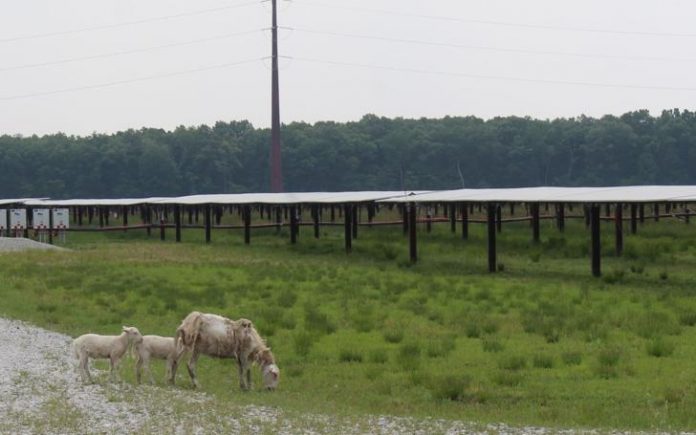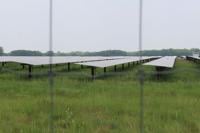- Mammoth North Solar sits on 4,500 acres in Starke County in Northwest Indiana. On this spot alone, 500 sheep graze beneath the panels.
-
Opposition against solar farms can be loud in the usually quiet, rural outskirts of Indiana.
White signs with variations of the words “Stop Solar” are often posted in front of soybean and corn fields, nailed to telephone poles and stationed in the front yards of the state’s many quaint farm houses.
Websites and opposition groups have sprung up all across the state and country. Stop Solar Farms, Stop Solar USA and Citizens for Responsible Solar are some of the organizations that express concern about solar projects.
But in Starke County in Northwest Indiana, Billy Bope has not put up a “Stop Solar” sign in his front yard. He is a farmer who has benefitted from a solar farm project.
Mammoth North Solar sits on more than 4,500 acres, including Bope’s. A 400-megawatt facility owned by Doral Renewables, based in Philadelphia, it produces enough electricity to supply around 75,000 homes across the Midwest.
Through its heavily invested use of agrivoltaics—the process of simultaneously using land both for energy production and agriculture—a symbiotic relationship with farmers has blossomed.
“It just makes sense,” said Christopher Kline, development manager for Doral Renewables.
The bright side
Bope’s family has always raised livestock. Farming has been passed down through the generations, from his 91-year-old father to Bope’s son. Mammoth North Solar has become a gateway for the practice to continue—the fields and pasture lands just look a little different.
Wildlife-friendly fencing is used around the solar panels on the Mammoth North Solar farm in Starke County.
Today, his flock of sheep graze beneath solar panels while sheepdogs like the Great Pyrenees watch over them. One 130-acre plot of land holds an estimated 500 sheep, around half lambs. Recently, Bope tried something new: The sheep had their lambs inside the solar fields, and the results were pleasantly surprising. Overall, the lambs were healthier and the birth process had fewer complications.
Bope said the solar panels provide shade for the animals as they graze, which significantly decreases their stress. The result is healthier, happier animals.
In exchange, the sheep have kept vegetation low, preventing grasses from growing to a height that would otherwise shade the solar panels and diminish their productivity. It also means that in the pasture areas of Mammoth North Solar, the company doesn’t need to pay for mowing services or herbicides, reducing the negative environmental impacts that would otherwise result.
Bope and the many other farmers who now farm on land that they leased to Mammoth North Solar have highlighted the potential for dual use and maximizing land when it comes to solar farms.
Kunekune pigs, alpacas, donkeys and, at one point, runner ducks have also lived within some of the fences of Mammoth North Solar, and there are plans to try cattle herds in the future. Doral Renewables is considering having beehives as well—a practice that other solar farms have used.
Grazing on solar fields isn’t a new idea—it has been used in Southwest states like Texas. In Indiana, with more rain, solar panels are less likely to be affected by dust and more likely to be affected by tall grasses. Grazing is an alternative.
Aside from livestock farming, around half of Mammoth North Solar’s land is located outside the solar fields. Regulations require solar fields to be set back 50-100 feet from roads and other properties. At Mammoth North Solar, farmers use these spaces to grow soybeans, corn, hay and wheat. Other setbacks that are not farmed are planted with native grasses and pollinator species.
Many of these methods could be more environmentally friendly than the lone corn and soybean fields that were originally there. Fencing is made to be wildlife friendly, and native grasses, even with sheep grazing on them, have fostered Indiana’s native ecosystems, said Kline. Bope has noticed an increase in native songbird species in the area. The grasses are also better at sequestering carbon compared to corn and soybeans.
Kline said Doral Renewables hires different consultants like ecologists to ensure that any harmful environmental impact of its projects are reduced.
“If we’re grazing sheep, maybe we’re shifting it from growing corn and beans to pastureland, where we’re grazing animals—we’re still farming,” Kline said.
He said that farmers have a history of evolving with the needs of the public, recalling something a Mammoth North Solar farmer once told him. When horses were the main method of transportation, they grew oats and hay to feed them. During the oil crisis of the 1970s and ‘80s, they grew corn for ethanol as a replacement. Now, as electric vehicles and data centers ramp up the energy needs of the country, farmers like Bope are beginning to support the electrical grid.
“Farmers change, change how they use the land,” Kline said.
When harvesting energy, solar farms produce no greenhouse gases, although materials required to make solar panels have manufacturing processes that do. At its most efficient, solar power is also the cheapest form of energy. Unless the sky is pitch black, solar panels are always harvesting energy and are designed to change position depending on weather in order to maximize energy production and keep the panels safe from damage.
The solar panels are also easily removed from the ground if needed, making it easy to convert the land back to farming fields once the project is decommissioned. Mammoth North Solar also pays economic development funds to the county, which puts money back into the community.
Locally, the solar panels have faded into the background, and it seems most concerns have as well.
The darker truths
Like any other solar project, Mammoth North Solar faced opposition. The project site is a rural farming community. The flat, treeless fields of northern and central Indiana are often sought after by solar farmers because they are easily built on and have miles of empty space. Having fewer people around also means fewer people are affected as compared to urban areas.
As a result, farming communities are usually the most directly affected by solar projects. In the lower 48 states, 40% of farmland is leased to farmers. If a property owner sells that land for a solar facility, the critical source of revenue can be lost. Those involved in the farming business through fertilizers, machinery and feed are affected too. In this way, solar farms can disrupt the cycle of agriculture.
Farmland has continued to decrease across the nation for years. From 2010 to 2022, 345,682 acres of farmland were lost in Indiana. It’s only a 1.89% decrease, but a decrease nonetheless. In the Hoosier state, agriculture alone provides over $35 billion to the state’s economy.
In comparison, solar farms require more surface area than coal or natural gas to produce the same amount of energy. Even then, although solar panels can still harvest energy when the sun is hidden, they do so less efficiently.
Citizens for Responsible Solar declined to interview with TheStatehouseFile.com, and Stop Solar Farms, Stop Solar USA did not respond to inquiries. Citizens for Responsible Solar does list its concerns on its website, however. They include solar power plants harming ecosystems and rural land and contributing to climate change, its driving force being big tech and federal subsidies, and its toxic waste production, unreliability and failure to be completed emissions free.
“Solar belongs on rooftops, near highways, commercial industrial zoned land, marginal or contaminated areas, not on rural-agricultural land,” the Citizens for Responsible Solar website states.
Some companies invest in rooftop and commercial solar power located in urban and commercial areas. However, solar companies are often more drawn to the hundreds of acres of farm fields that even warehouse rooftops cannot compare to in size. Additionally, roofs must be structurally sound and able to support solar panels. The added weight also makes repairs more difficult if damages occur..
Farmland often seems to be the best option for solar companies, often at the cost of the agricultural industry.
If the consequences do not involve farmland, they sometimes involve forests. Some solar projects have caused significant deforestation.
The solar industry has also become known for producing vast amounts of toxic waste. In 2050, researchers expect solar panel waste to reach an estimated 78 million metric tonnes. The technology of solar power is rapidly advancing as well—as more efficient, cheaper solar panels are developed, the old ones are discarded. Toxic chemicals like lead, antimony, cadmium and plastics are found in solar panels. This makes them difficult to recycle and dispose of safely. Discarding solar panels in landfills can expose the soil to toxic materials.
Mining some of these toxic materials also contributes to a carbon footprint. Harvesting solar energy itself may produce no carbon emissions, but the materials that some solar panels are made of require processes that do. Silicon, silver, lithium and other materials used to manufacture solar panels are extracted using processes that release greenhouse gases and environmental contaminants. Manufacturing facilities for solar panels may also be powered by nonrenewable energy sources like oil or coal.
What’s on the horizon?
“When you talk about energy and when you talk about our national energy needs, there’s not just one solution,” Kline said. “It’s not just one source of energy is what we need. It’s definitely a mix. And solar has a key role in that mix and a growing role.”
In Pulaski County, Doral Renewables broke ground a few years ago for Mammoth Central and South. Combined with Mammoth North, the Mammoth Solar project is expected to produce 1.3 gigawatts—enough for 275,000 houses annually. In total, all three projects will sit on 13,000 acres. The construction, similar to Mammoth North, has provided jobs for carpenters, electricians, heavy equipment operators and other craftworkers within the community.
Mammoth South and Central are expected to go online in 2027, bringing even more renewable energy onto the energy grid through MISO and PJM—operators of the electric grid across the Midwest.
Counties across the state, such as Henry, Hendricks, Hamilton and Boone, continue to restrict and push back against solar projects, and different requirements depending on the area make solar farm implementation difficult.
Kline feels that misinformation concerning solar facilities is easily spread and could be a reason for pushback across Indiana.
But he also believes that the more energy a society uses, the more successful and healthy it is.
“There is a reason that the government promotes energy production, and solar is a part of that,” he said.
Today, just over 4% of Indiana energy is solar, and that number is expected to rise. Kline thinks the future is bright.
As solar facilities continue to grow, the question is, who will retain their white “Stop Solar” signs and who will put them away?
Olivia O’Neal is a reporter for TheStatehouseFile.com, a news site powered by Franklin College journalism students.
-
What does the property owner have to say?
-
Pretty good article, although much of what the anti solar groups say is false, fossil fuel industry propaganda. If we don’t wean from fossil to renewable asap, we have no hope of stopping the climate crisis and saving our planet. And don’t the critics believe in private property? I have solar for my 100% electric house in Jasper County and some months the electric company pays me credits!
Comments are closed.







(0) COMMENTS